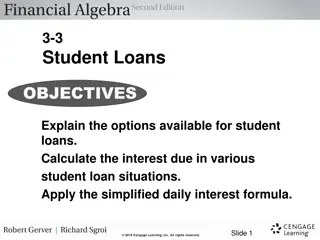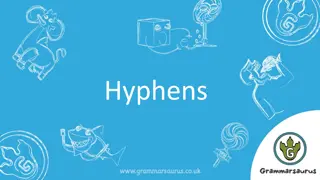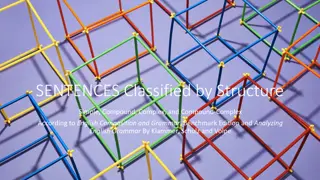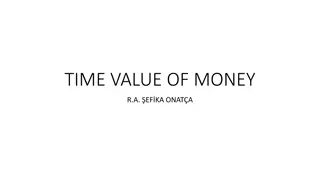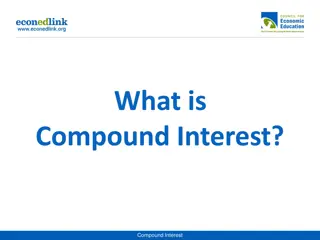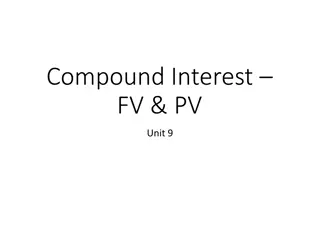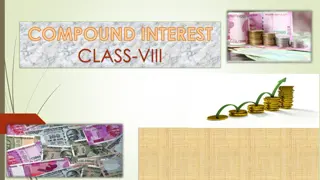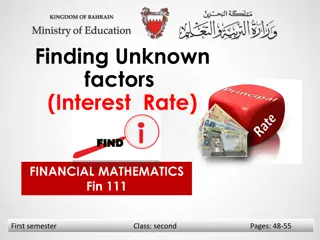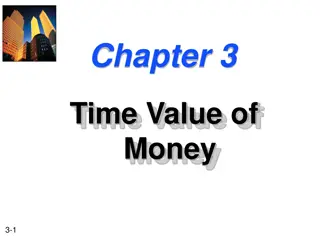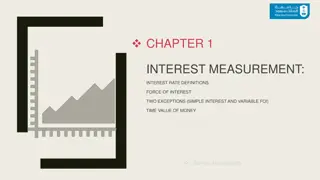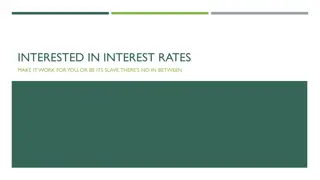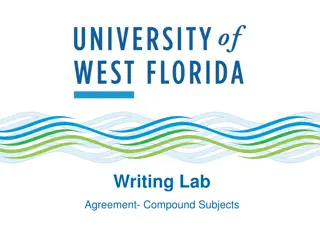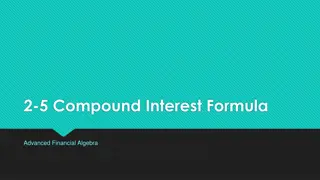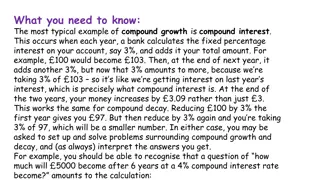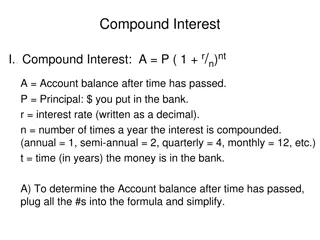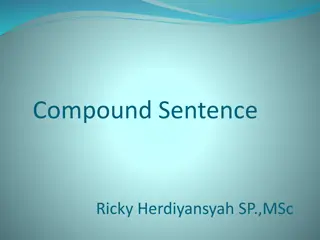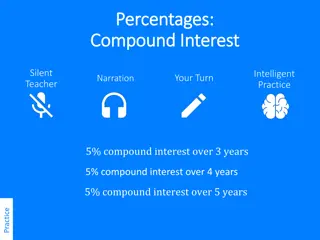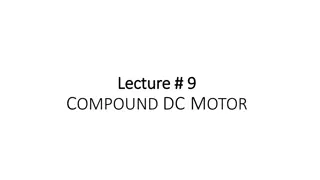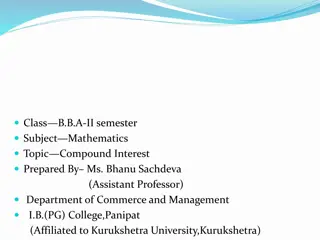Understanding Compound Interest: A Practical Guide
Compound interest is a powerful financial concept that can significantly impact your savings and investments. This guide explains how compound interest works using geometric series and provides a step-by-step solution to a compound interest problem. Learn about the types of interest, the difference between simple and compound interest, and how to calculate compound interest using methods like increase and add on or using a multiplier. Start mastering the art of compound interest today to make informed financial decisions!
Download Presentation

Please find below an Image/Link to download the presentation.
The content on the website is provided AS IS for your information and personal use only. It may not be sold, licensed, or shared on other websites without obtaining consent from the author. Download presentation by click this link. If you encounter any issues during the download, it is possible that the publisher has removed the file from their server.
E N D
Presentation Transcript
Saturday, 21 September 2024 LO: Use geometric series to work problems about compound interest. www.mathssupport.org www.mathssupport.org
COMPOUND INTEREST Since this section involves what can happen to your money, it should be of INTEREST to you! At some point in life, most people need either invest or borrow money. When money is lent, the person lending the money is know as the lender, and the person receiving the money is known as the borrower. The amount borrowed is called the principal www.mathssupport.org www.mathssupport.org
Types of Interest The lender usually charges a fee called interest to the borrower. This fee represents the cost of using the other person s money. The borrower must repay the principal borrowed as well as the interest charged for using that money. The rate at which interest is charged is usually expressed as a percentage of the principal. This percentage is known as the interest rate, and it is an important factor when deciding where to invest your money and where to borrow money from. www.mathssupport.org www.mathssupport.org
Types of Interest When money is deposited in a bank, the bank will usually pay interest to the owner of the account. There are two ways to pay interest Simple Interest Interest paid (earned) on only the original amount, or principal, borrowed (lent). Compound Interest Interest paid (earned) on any previous interest earned, as well as on the principal borrowed (lent). When money is deposited in a bank, it will usually earn compound interest. www.mathssupport.org www.mathssupport.org
Compound interest Jack puts 500 into a savings account with an annual compound interest rate of 5%. How much will he have in the account at the end of 4 years if he doesn t add or withdraw any money? At the end of each year interest is added to the total amount in the account. This means that each year 5% of an ever larger amount is added to the account. Making calculations such as this are sometimes called compound interest problems. There are two ways to solve such problems. Method 1 Increase and add on. Method 2 Use a multiplier www.mathssupport.org www.mathssupport.org
Compound interest Method 1 Increase and add on Calculate the amount of interest earned after each year and add it to the previous year s total, as shown below. After first year: 5% of 500 = 25, which gives Jack 500 + 25 = 525 After second year: 5% of 525 = 26.25, which gives Jack 525 + 26.25 = 551.25 After third year: 5% of 551.25 = 27.56, which gives Jack 551.25 + 27.56 = 578.81 After fourth year: 5% of 578.81 = 28.94, which gives Jack 578.81 + 28.94 = 607.75 (These amounts are written to the nearest penny.) At the end of year 4 Jack has 607.75 www.mathssupport.org www.mathssupport.org
Compound interest Method 2 Use a multiplier When dealing with percentage increase, the multiplier is found by adding the percentage increase expressed as a decimal to 1, which represents the original value. So, in this case, the multiplier is given by 1 + 0.05 = 1.05 (When dealing with a percentage decrease, the multiplier is found by subtracting the decrease from 1, which gives a value for the multiplier of less than 1.) www.mathssupport.org www.mathssupport.org
Compound interest Method 2 Use a multiplier 500 1.05 = 525 At the end of year 1 Jack has At the end of year 2 Jack has 500 1.05 1.05 = 551.25 500 1.052 = 551.25 At the end of year 3 Jack has 500 1.05 1.05 1.05 = 578.81 500 1.053 = 578.81 At the end of year 4 Jack has 500 1.05 1.05 1.05 1.05 = 607.75 500 1.054 = 607.75 If the money is left in your account for n years it will amount to 500 (1.05)n We have a geometric sequence with first term (u1) 500, common ratio (r) 1.05 and time period (n) un = u1 (r)n where r = (1 + i) andiis the interest rate and u1is the initial amount www.mathssupport.org www.mathssupport.org
The Compound interest formula For interest compounding annually ( n ) r FV = PV 1 + 100 Where: FV is the future value or final balance PV is the present value or amount originally invested r is the interest rate per year n is the number of years www.mathssupport.org www.mathssupport.org
Compound interest ( n ) r FV = PV1 + 100 $5 000 is invested for 4 years at 7% p.a. compound interest, compounded annually. What will it amount to at the end of this period? Give the answer to the nearest cent. ( n ) 7 100 r FV = PV1 + PV = r = n = 5 000 7 4 100 ( 4 ) FV = 5 000 1 + FV = ? FV 6 553.98 The investment amounts to $6 553.98 How much interest has been earned? Interest earned = FV PV 6 553.98 $1 553.98 5 000 = = www.mathssupport.org www.mathssupport.org
The Compound interest formula Interest can be compounded more than once per year, Interest is commonly compounded: half-yearly (2 times per year) k = 2 quarterly (4 times per year) k = 4 k = 12 monthly (12 times per year) For interest compounding k times per year ( kn ) r FV = PV 1 + 100k www.mathssupport.org www.mathssupport.org
Compound interest ( kn ) r FV = PV 1 + 100k $5 000 is invested for 4 years at 7% p.a. compound interest, compounded monthly. Calculate the final balance. ( kn ) r PV = 5 000 FV = PV 1 + 100k 7 r = n = k = 12 ( ( 12 4 ) 7 4 FV = 5000 1 + 100 12 48 ) 7 FV = ? FV = 5000 1 + 1200 FV 6 610.27 The final balance is $6 610.27 www.mathssupport.org www.mathssupport.org
Interest earned ( kn ) r FV = PV 1 + 100k The interest earned is the difference between the original balance and the final balance Interest = FV PV How much interest is earned if $8 000 is placed in an account that pays 4 % p.a. compounded quarterly for 3 years. ( ( ( Interest = ? Interest = FV PV Interest = 9356.41 8000 Interest = $1356.41 The interest earned is $1356.41 kn ) r PV = r = n = k = 4 8 000 4.5 3.5 FV = PV 1 + 100k 4 3.5 ) 4.5 FV = 8000 1 + 100 4 FV = ? 14 ) 7 FV = 8000 1 + FV 9 356.41 400 www.mathssupport.org www.mathssupport.org
Using a GDC for Compound Interest There is a financial program that can be used in you calculator We are going to use a Graphing display calculator to solve problems about Compound Interest Texas Instruments www.mathssupport.org www.mathssupport.org
Using a GDC for compound interest TI 84 There is a financial program that can be used in you calculator We are going to use TVM solver This is called TVM solver, where TVM stands for time value of money 1: Finance Tap on APPS www.mathssupport.org www.mathssupport.org
Using a GDC for compound interest TI 84 There is a financial program that can be used in you calculator We are going to use TVM solver This is called TVM solver, where TVM stands for time value of money 1: Finance Tap on APPS 1: TVM Solver www.mathssupport.org www.mathssupport.org
Using a GDC for compound interest TI 84 There is a financial program that can be used in you calculator We are going to use TVM solver This is called TVM solver, where TVM stands for time value of money 1: Finance Tap on APPS The following abbreviations are used: 1: TVM Solver N: represents the number of time periods I%: represents the interest rate per year PV: represents the present value PMT: represents the payment each time period FV: represents the future value P/Y: is the number of payments per year C/Y: is the number of compounding periods per year www.mathssupport.org www.mathssupport.org
Using a GDC for compound interest TI 84 Connie invest 12 000 in an account that pays 3.75% p.a. compounded monthly. How much is her investment worth after 6 years? Set up the TVM screen Since it is compounded monthly there are 6 12 = 72 month periods, so, N = 72 I% = 3.75% ENTER ENTER The initial investment (PV) is considered as an outgoing and is entered as a negative value PV = PMT = FV = P/Y = C/Y = 12 ENTER With the arrow move the cursor up to FV 12 000 No needed, leave 0 It is our unknown 12 ENTER ENTER PressALPHA ENTER www.mathssupport.org www.mathssupport.org
Using a GDC for compound interest TI 84 Connie invest 12 000 in an account that pays 3.75% p.a. compounded monthly. How much is her investment worth after 6 years? The value after 6 years is: 15 022.60 www.mathssupport.org www.mathssupport.org
Using a GDC for compound interest TI 84 How much does Alfred need to deposit into an account to collect 20 000 OMR at the end of 5 years if the account is paying 3.2% p.a. compounded quarterly? Set up the TVM screen Since it is compounded quarterly there are 5 4 = 20 month periods, so, N = 20 I% = PV = PMT = No needed, leave 0 ENTER 3.2% It is our unknown ENTER The Final value should be a positive value FV = P/Y = C/Y = 4 ENTER With the arrow move the cursor up to PV 20 000 4 ENTER ENTER PressALPHA ENTER www.mathssupport.org www.mathssupport.org
Using a GDC for compound interest TI 84 How much does Alfred need to deposit into an account to collect 20 000 OMR at the end of 5 years if the account is paying 3.2% p.a. compounded quarterly? Alfred needs to deposit 17 053.729 OMR www.mathssupport.org www.mathssupport.org
Using a GDC for compound interest TI 84 For how long must Kapil invest 6 000 at 4.75% p.a. compounded half-yearly for it to amount 10 000? Set up the TVM screen We need to find N, the number of periods required, so, N = 0 4.75% -6000 ENTER ENTER I% = PV = PMT = ENTER No needed, leave 0 The Final value should be a positive value FV = P/Y = C/Y = 2 ENTER 10 000 2 ENTER ENTER With the arrow move the cursor up to N PressALPHA ENTER www.mathssupport.org www.mathssupport.org
Using a GDC for compound interest TI 84 For how long must Kapil invest 6 000 at 4.75% p.a. compounded half-yearly for it to amount 10 000? N = 21.8, so 22 half-years are required, or 11 years www.mathssupport.org www.mathssupport.org
Using a GDC for compound interest TI 84 Marwan deposits 3 500 in an account that compounds interest monthly 5 years later the account totals 5 000. What annual rate of interest was paid? Set up the TVM screen Since it is compounded monthly there are 5 12 = 60 month periods, so, N = 60 I% = PV = PMT = No needed, leave 0 ENTER It is our unknown ENTER -3500 The Final value should be a positive value FV = P/Y = C/Y = 12 ENTER 5000 12 ENTER ENTER With the arrow move the cursor up to I PressALPHA ENTER www.mathssupport.org www.mathssupport.org
Using a GDC for compound interest TI 84 Marwan deposits 3 500 in an account that compounds interest monthly 5 years later the account totals 5 000. What annual rate of interest was paid? An annual interest rate of 7.15% p.a. is required www.mathssupport.org www.mathssupport.org
Thank you for using resources from A close up of a cage Description automatically generated For more resources visit our website https://www.mathssupport.org If you have a special request, drop us an email info@mathssupport.org www.mathssupport.org www.mathssupport.org



